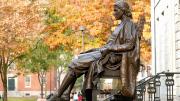The John Harvard statue is probably the most touched object in the University. Its left foot is subjected to almost incessant rubbing by tourists who believe that the act brings good luck; the standard pose, for photos, is to place a hand on John Harvard’s shoe, which has become shiny from the human contact.
But Harvard students themselves know better than to touch it—not least because one of three traditional deeds* that some College students strive to complete before graduation involves urinating on John Harvard.
So, how clean is the John Harvard statue?
Administrative staff in charge of its maintenance say the statue is cleaned on an as-needed basis, and is power-washed five to six times a year. “The maintenance really revolves around when the students do their business on it,” reports Joel Day, the facilities manager of University Hall. “The grounds crew are good at noticing; sometimes you can walk by and it smells like it needs to be cleaned.” The statue is not washed during winter, he adds, because hosing it in freezing temperatures would create slipping hazards.
The statue has long been a popular site for creative expression. People from inside and outside the University have decorated it with a variety of paraphernalia, including orange cones, pumpkins, garlands, and clothes. (“I’m a little hesitant as far as giving too many details, because it gives people ideas,” says Maureen McCarthy, manager of Harvard Yard.) Most incidents of vandalism occur during football seasons, when students from peer institutions visit Harvard and wish to leave their mark, says Paul Smith, an associate manager of landscape services.
The most dramatic damage to the statue in recent memory occurred when some Dartmouth affiliates threw oil-based green paint on it in 2012. The maintenance staff was unable to remove the paint, and the statue stayed green for several months—“It looked terrible,” Smith says, “the worst I’ve seen.” Finally the University hired Stuart Dean, a company that specializes in metal restoration, to re-oxidize and refinish the statue. According to Peter Pappas, a Stuart Dean employee in charge of the restoration project, the refinishing cost Harvard at least $5,000.
For most of its existence, the bronze sculpture has received no professional treatment or maintenance, according to Henry Lie, the conservator of objects and sculpture at Harvard Art Museums. Fortunately, a wax coating has protected its surface from natural elements and graffiti. So far, he adds, the sundry acts of vandalism have resulted in no permanent damage, and the statue has not changed much in the 132 years since it was created—except for its gleaming left foot. That foot is also the only part of John Harvard that does not require any treatment or maintenance—that job is done by tourists, whose fingers prevent patina from developing. “No coating,” Lie says, “can withstand the constant mildly abrasive touching that occurs.”
Do the maintenance staff themselves think it’s hygienic to touch the statue?
“I don’t imagine it would be hygienic, but I don’t know how you would avoid it,” says McCarthy.
“They really should put a sanitizing station there,” says Day.
“I wouldn’t do it,” says Smith.
* The other two are primal scream (the naked run on the night before final exams begin) and having sex in the Widener stacks.









